Mark & Spencer Business Communication Analysis Report
VerifiedAdded on 2020/01/07
|14
|5602
|719
Report
AI Summary
This report provides a comprehensive overview of business communication, defining communication and its importance within organizations, specifically referencing Mark & Spencer. It details the fundamental steps involved in the communication process, including establishing intent, message composition, encoding, signal transmission, reception, decoding, and interpretation. The report defines business communication in various contexts, highlighting the exchange of ideas and information to achieve organizational goals. It distinguishes between formal and informal modes of communication, outlining their respective advantages and disadvantages. The report explores the benefits of effective communication, such as motivation, information sharing, attitude changes, and social interaction. It also details the communication process, including the roles of the sender, ideas, encoding, communication channels, the receiver, decoding, and feedback. The report underscores the importance of understanding these elements for effective communication within a business environment.
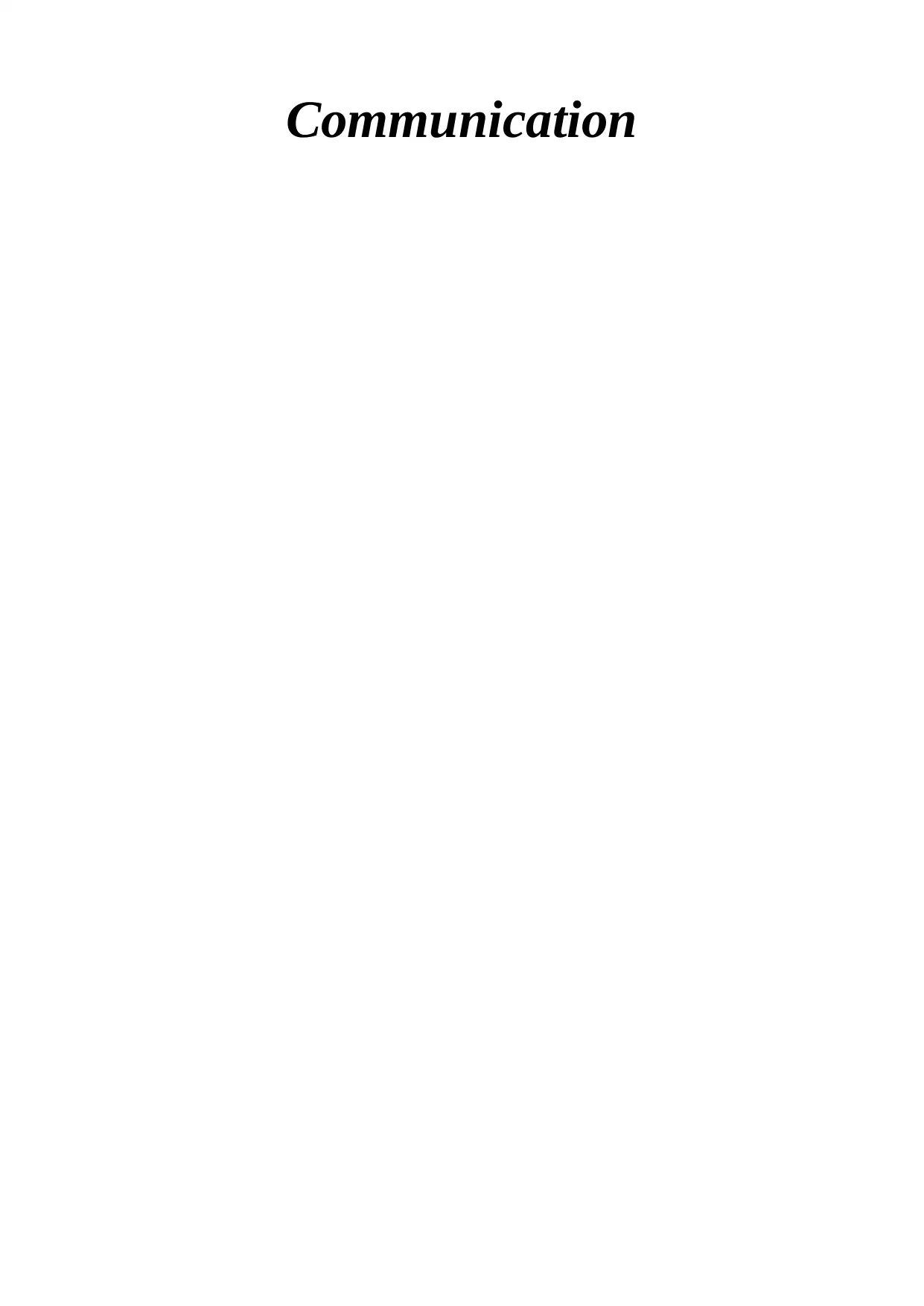
Communication
Paraphrase This Document
Need a fresh take? Get an instant paraphrase of this document with our AI Paraphraser
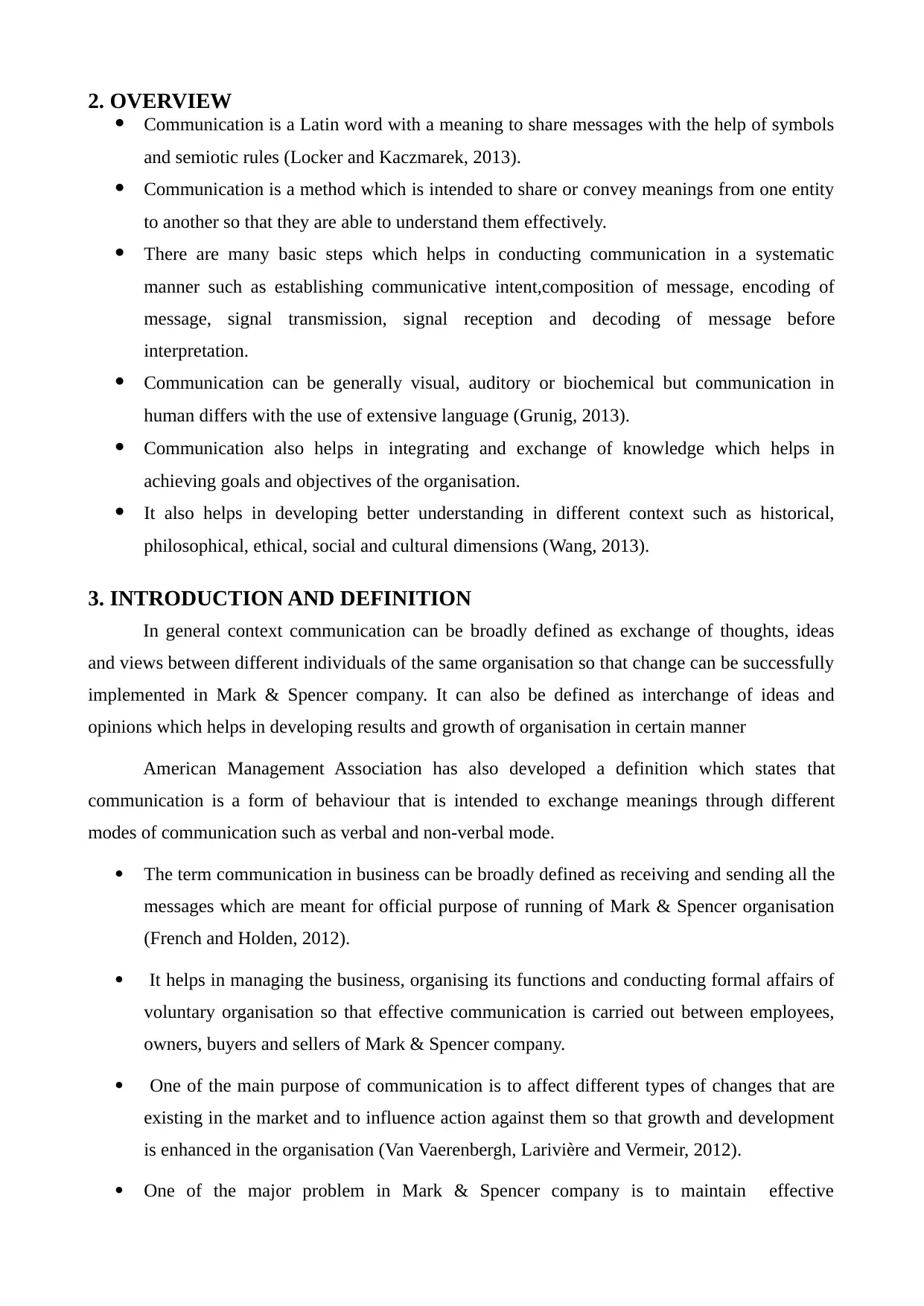
2. OVERVIEW
Communication is a Latin word with a meaning to share messages with the help of symbols
and semiotic rules (Locker and Kaczmarek, 2013).
Communication is a method which is intended to share or convey meanings from one entity
to another so that they are able to understand them effectively.
There are many basic steps which helps in conducting communication in a systematic
manner such as establishing communicative intent,composition of message, encoding of
message, signal transmission, signal reception and decoding of message before
interpretation.
Communication can be generally visual, auditory or biochemical but communication in
human differs with the use of extensive language (Grunig, 2013).
Communication also helps in integrating and exchange of knowledge which helps in
achieving goals and objectives of the organisation.
It also helps in developing better understanding in different context such as historical,
philosophical, ethical, social and cultural dimensions (Wang, 2013).
3. INTRODUCTION AND DEFINITION
In general context communication can be broadly defined as exchange of thoughts, ideas
and views between different individuals of the same organisation so that change can be successfully
implemented in Mark & Spencer company. It can also be defined as interchange of ideas and
opinions which helps in developing results and growth of organisation in certain manner
American Management Association has also developed a definition which states that
communication is a form of behaviour that is intended to exchange meanings through different
modes of communication such as verbal and non-verbal mode.
The term communication in business can be broadly defined as receiving and sending all the
messages which are meant for official purpose of running of Mark & Spencer organisation
(French and Holden, 2012).
It helps in managing the business, organising its functions and conducting formal affairs of
voluntary organisation so that effective communication is carried out between employees,
owners, buyers and sellers of Mark & Spencer company.
One of the main purpose of communication is to affect different types of changes that are
existing in the market and to influence action against them so that growth and development
is enhanced in the organisation (Van Vaerenbergh, Larivière and Vermeir, 2012).
One of the major problem in Mark & Spencer company is to maintain effective
Communication is a Latin word with a meaning to share messages with the help of symbols
and semiotic rules (Locker and Kaczmarek, 2013).
Communication is a method which is intended to share or convey meanings from one entity
to another so that they are able to understand them effectively.
There are many basic steps which helps in conducting communication in a systematic
manner such as establishing communicative intent,composition of message, encoding of
message, signal transmission, signal reception and decoding of message before
interpretation.
Communication can be generally visual, auditory or biochemical but communication in
human differs with the use of extensive language (Grunig, 2013).
Communication also helps in integrating and exchange of knowledge which helps in
achieving goals and objectives of the organisation.
It also helps in developing better understanding in different context such as historical,
philosophical, ethical, social and cultural dimensions (Wang, 2013).
3. INTRODUCTION AND DEFINITION
In general context communication can be broadly defined as exchange of thoughts, ideas
and views between different individuals of the same organisation so that change can be successfully
implemented in Mark & Spencer company. It can also be defined as interchange of ideas and
opinions which helps in developing results and growth of organisation in certain manner
American Management Association has also developed a definition which states that
communication is a form of behaviour that is intended to exchange meanings through different
modes of communication such as verbal and non-verbal mode.
The term communication in business can be broadly defined as receiving and sending all the
messages which are meant for official purpose of running of Mark & Spencer organisation
(French and Holden, 2012).
It helps in managing the business, organising its functions and conducting formal affairs of
voluntary organisation so that effective communication is carried out between employees,
owners, buyers and sellers of Mark & Spencer company.
One of the main purpose of communication is to affect different types of changes that are
existing in the market and to influence action against them so that growth and development
is enhanced in the organisation (Van Vaerenbergh, Larivière and Vermeir, 2012).
One of the major problem in Mark & Spencer company is to maintain effective
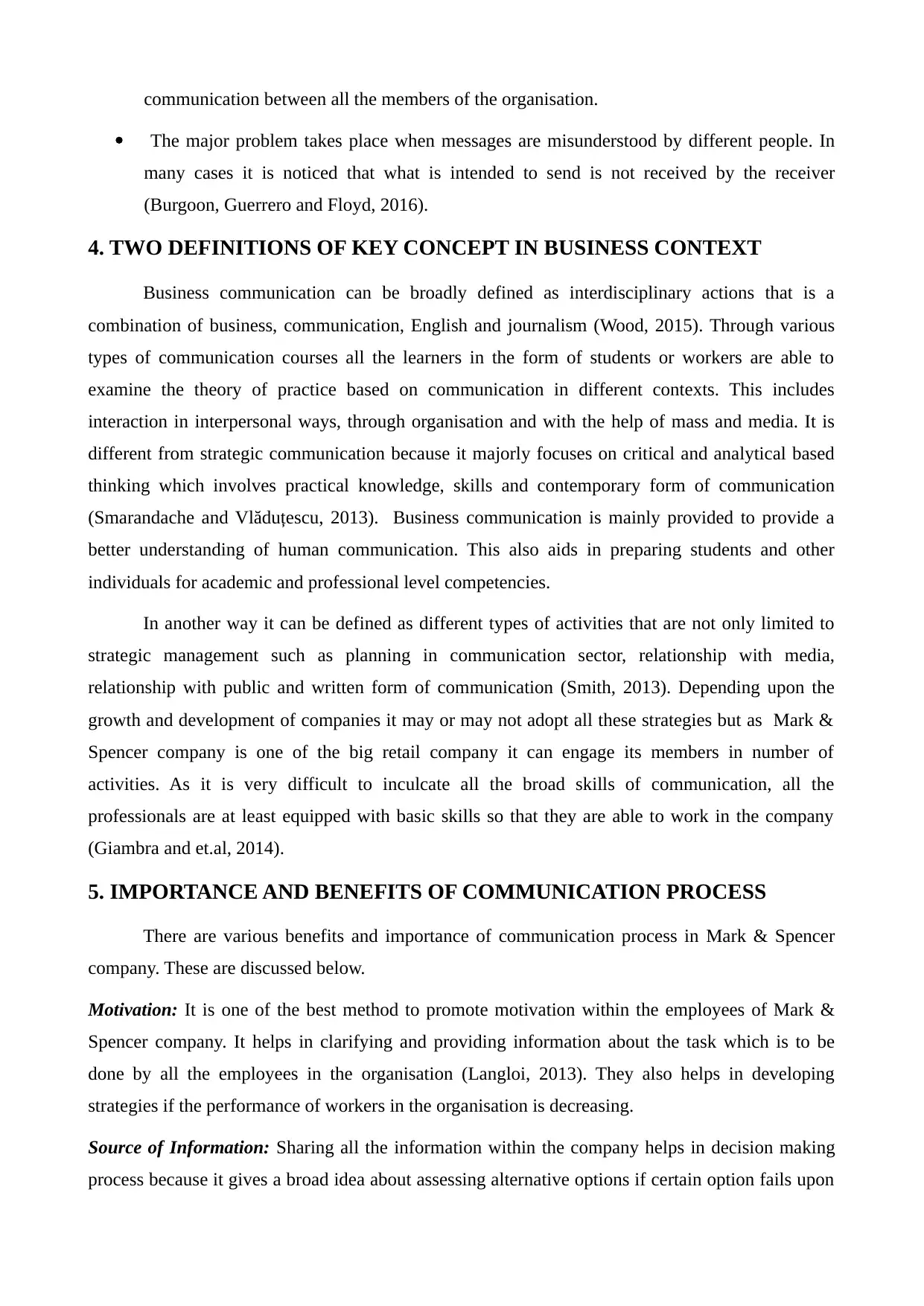
communication between all the members of the organisation.
The major problem takes place when messages are misunderstood by different people. In
many cases it is noticed that what is intended to send is not received by the receiver
(Burgoon, Guerrero and Floyd, 2016).
4. TWO DEFINITIONS OF KEY CONCEPT IN BUSINESS CONTEXT
Business communication can be broadly defined as interdisciplinary actions that is a
combination of business, communication, English and journalism (Wood, 2015). Through various
types of communication courses all the learners in the form of students or workers are able to
examine the theory of practice based on communication in different contexts. This includes
interaction in interpersonal ways, through organisation and with the help of mass and media. It is
different from strategic communication because it majorly focuses on critical and analytical based
thinking which involves practical knowledge, skills and contemporary form of communication
(Smarandache and Vlăduțescu, 2013). Business communication is mainly provided to provide a
better understanding of human communication. This also aids in preparing students and other
individuals for academic and professional level competencies.
In another way it can be defined as different types of activities that are not only limited to
strategic management such as planning in communication sector, relationship with media,
relationship with public and written form of communication (Smith, 2013). Depending upon the
growth and development of companies it may or may not adopt all these strategies but as Mark &
Spencer company is one of the big retail company it can engage its members in number of
activities. As it is very difficult to inculcate all the broad skills of communication, all the
professionals are at least equipped with basic skills so that they are able to work in the company
(Giambra and et.al, 2014).
5. IMPORTANCE AND BENEFITS OF COMMUNICATION PROCESS
There are various benefits and importance of communication process in Mark & Spencer
company. These are discussed below.
Motivation: It is one of the best method to promote motivation within the employees of Mark &
Spencer company. It helps in clarifying and providing information about the task which is to be
done by all the employees in the organisation (Langloi, 2013). They also helps in developing
strategies if the performance of workers in the organisation is decreasing.
Source of Information: Sharing all the information within the company helps in decision making
process because it gives a broad idea about assessing alternative options if certain option fails upon
The major problem takes place when messages are misunderstood by different people. In
many cases it is noticed that what is intended to send is not received by the receiver
(Burgoon, Guerrero and Floyd, 2016).
4. TWO DEFINITIONS OF KEY CONCEPT IN BUSINESS CONTEXT
Business communication can be broadly defined as interdisciplinary actions that is a
combination of business, communication, English and journalism (Wood, 2015). Through various
types of communication courses all the learners in the form of students or workers are able to
examine the theory of practice based on communication in different contexts. This includes
interaction in interpersonal ways, through organisation and with the help of mass and media. It is
different from strategic communication because it majorly focuses on critical and analytical based
thinking which involves practical knowledge, skills and contemporary form of communication
(Smarandache and Vlăduțescu, 2013). Business communication is mainly provided to provide a
better understanding of human communication. This also aids in preparing students and other
individuals for academic and professional level competencies.
In another way it can be defined as different types of activities that are not only limited to
strategic management such as planning in communication sector, relationship with media,
relationship with public and written form of communication (Smith, 2013). Depending upon the
growth and development of companies it may or may not adopt all these strategies but as Mark &
Spencer company is one of the big retail company it can engage its members in number of
activities. As it is very difficult to inculcate all the broad skills of communication, all the
professionals are at least equipped with basic skills so that they are able to work in the company
(Giambra and et.al, 2014).
5. IMPORTANCE AND BENEFITS OF COMMUNICATION PROCESS
There are various benefits and importance of communication process in Mark & Spencer
company. These are discussed below.
Motivation: It is one of the best method to promote motivation within the employees of Mark &
Spencer company. It helps in clarifying and providing information about the task which is to be
done by all the employees in the organisation (Langloi, 2013). They also helps in developing
strategies if the performance of workers in the organisation is decreasing.
Source of Information: Sharing all the information within the company helps in decision making
process because it gives a broad idea about assessing alternative options if certain option fails upon
⊘ This is a preview!⊘
Do you want full access?
Subscribe today to unlock all pages.

Trusted by 1+ million students worldwide

implementation.
Changes in attitude: It is very important to mould the behaviour and attitude of all the employees
in a positive manner because it affects company's image and reputation in direct or indirect manner
(Coombs, 2014). A person who is well informed about all duties and roles in the company will be
incorporate positive behaviour as compared to individual who is not well informed. There are
different types of forms which can help in shaping individual's attitude in optimistic manner.
Help in socializing: Communication is one of the most important way that promotes interaction
between social groups so that information is shared between different members. Communication
plays a very important role because in today's advanced world no one is able to survive without
communication (Roman and et.al, 2013).
Process of controlling: In all the organisation certain level of hierarchy is maintained that should be
followed by all the members of Mark & Spencer company. This helps in controlling the process of
organisation and behaviour in appropriate manner. To follow the process of company in appropriate
manner it is very necessary to adhere to principles and guidelines that are formulated by
organisation (Knapp, Hall and Horgan, 2013). If any problem occurs they should communicate this
to their superiors and higher authority members so that they can rectify and sort the existing
problem.
6. FORMAL AND INFORMAL MODE OF COMMUNICATION
For different individuals various types of communication are used so that thoughts, ideas
and opinions are exchanged in a proper way (Dima and Vladutescu, 2013). The effectiveness of
communication solely depends on the type of communication which is adopted by members of
Mark & Spencer company. Mainly there are two types of communication that can take place at
workplace.
Formal mode of communication
This mode of communication is generally in the form of different types of policies, manuals,
procedures meetings, conference and various reports (Smarandache and Vlăduțescu, 2013).
Formal meetings and conferences are arranged for internal and external stakeholder so that
the company is able to decide on various important matters and issues.
Communication that is initiated with the help of formal channels is known as formal
communication (Locker and Kaczmarek, 2013).
If any type of information is to be circulated in the company or to other sources then this can
be done through formal mode of communication such as printing brochures, templates,
Changes in attitude: It is very important to mould the behaviour and attitude of all the employees
in a positive manner because it affects company's image and reputation in direct or indirect manner
(Coombs, 2014). A person who is well informed about all duties and roles in the company will be
incorporate positive behaviour as compared to individual who is not well informed. There are
different types of forms which can help in shaping individual's attitude in optimistic manner.
Help in socializing: Communication is one of the most important way that promotes interaction
between social groups so that information is shared between different members. Communication
plays a very important role because in today's advanced world no one is able to survive without
communication (Roman and et.al, 2013).
Process of controlling: In all the organisation certain level of hierarchy is maintained that should be
followed by all the members of Mark & Spencer company. This helps in controlling the process of
organisation and behaviour in appropriate manner. To follow the process of company in appropriate
manner it is very necessary to adhere to principles and guidelines that are formulated by
organisation (Knapp, Hall and Horgan, 2013). If any problem occurs they should communicate this
to their superiors and higher authority members so that they can rectify and sort the existing
problem.
6. FORMAL AND INFORMAL MODE OF COMMUNICATION
For different individuals various types of communication are used so that thoughts, ideas
and opinions are exchanged in a proper way (Dima and Vladutescu, 2013). The effectiveness of
communication solely depends on the type of communication which is adopted by members of
Mark & Spencer company. Mainly there are two types of communication that can take place at
workplace.
Formal mode of communication
This mode of communication is generally in the form of different types of policies, manuals,
procedures meetings, conference and various reports (Smarandache and Vlăduțescu, 2013).
Formal meetings and conferences are arranged for internal and external stakeholder so that
the company is able to decide on various important matters and issues.
Communication that is initiated with the help of formal channels is known as formal
communication (Locker and Kaczmarek, 2013).
If any type of information is to be circulated in the company or to other sources then this can
be done through formal mode of communication such as printing brochures, templates,
Paraphrase This Document
Need a fresh take? Get an instant paraphrase of this document with our AI Paraphraser
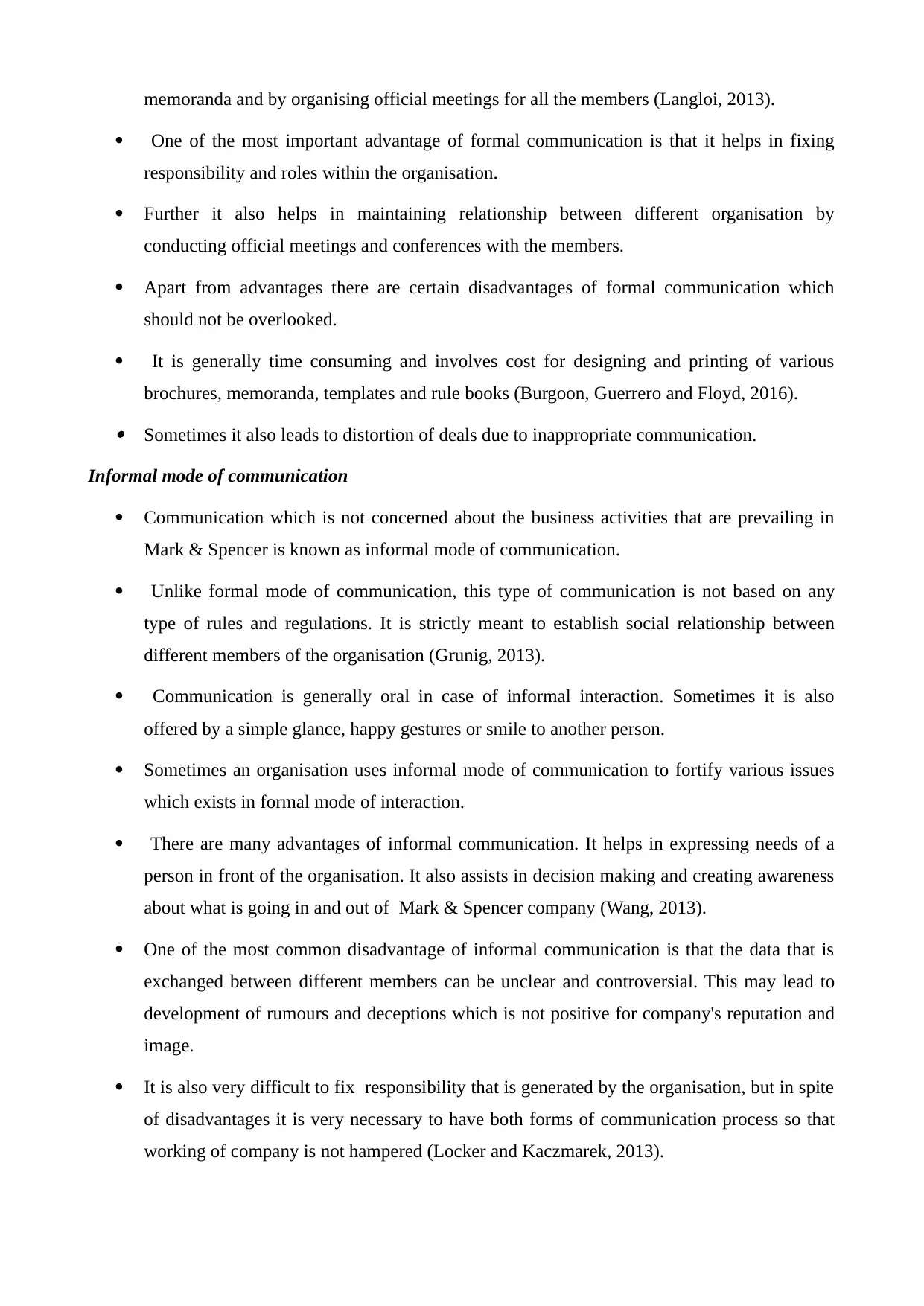
memoranda and by organising official meetings for all the members (Langloi, 2013).
One of the most important advantage of formal communication is that it helps in fixing
responsibility and roles within the organisation.
Further it also helps in maintaining relationship between different organisation by
conducting official meetings and conferences with the members.
Apart from advantages there are certain disadvantages of formal communication which
should not be overlooked.
It is generally time consuming and involves cost for designing and printing of various
brochures, memoranda, templates and rule books (Burgoon, Guerrero and Floyd, 2016).
Sometimes it also leads to distortion of deals due to inappropriate communication.
Informal mode of communication
Communication which is not concerned about the business activities that are prevailing in
Mark & Spencer is known as informal mode of communication.
Unlike formal mode of communication, this type of communication is not based on any
type of rules and regulations. It is strictly meant to establish social relationship between
different members of the organisation (Grunig, 2013).
Communication is generally oral in case of informal interaction. Sometimes it is also
offered by a simple glance, happy gestures or smile to another person.
Sometimes an organisation uses informal mode of communication to fortify various issues
which exists in formal mode of interaction.
There are many advantages of informal communication. It helps in expressing needs of a
person in front of the organisation. It also assists in decision making and creating awareness
about what is going in and out of Mark & Spencer company (Wang, 2013).
One of the most common disadvantage of informal communication is that the data that is
exchanged between different members can be unclear and controversial. This may lead to
development of rumours and deceptions which is not positive for company's reputation and
image.
It is also very difficult to fix responsibility that is generated by the organisation, but in spite
of disadvantages it is very necessary to have both forms of communication process so that
working of company is not hampered (Locker and Kaczmarek, 2013).
One of the most important advantage of formal communication is that it helps in fixing
responsibility and roles within the organisation.
Further it also helps in maintaining relationship between different organisation by
conducting official meetings and conferences with the members.
Apart from advantages there are certain disadvantages of formal communication which
should not be overlooked.
It is generally time consuming and involves cost for designing and printing of various
brochures, memoranda, templates and rule books (Burgoon, Guerrero and Floyd, 2016).
Sometimes it also leads to distortion of deals due to inappropriate communication.
Informal mode of communication
Communication which is not concerned about the business activities that are prevailing in
Mark & Spencer is known as informal mode of communication.
Unlike formal mode of communication, this type of communication is not based on any
type of rules and regulations. It is strictly meant to establish social relationship between
different members of the organisation (Grunig, 2013).
Communication is generally oral in case of informal interaction. Sometimes it is also
offered by a simple glance, happy gestures or smile to another person.
Sometimes an organisation uses informal mode of communication to fortify various issues
which exists in formal mode of interaction.
There are many advantages of informal communication. It helps in expressing needs of a
person in front of the organisation. It also assists in decision making and creating awareness
about what is going in and out of Mark & Spencer company (Wang, 2013).
One of the most common disadvantage of informal communication is that the data that is
exchanged between different members can be unclear and controversial. This may lead to
development of rumours and deceptions which is not positive for company's reputation and
image.
It is also very difficult to fix responsibility that is generated by the organisation, but in spite
of disadvantages it is very necessary to have both forms of communication process so that
working of company is not hampered (Locker and Kaczmarek, 2013).
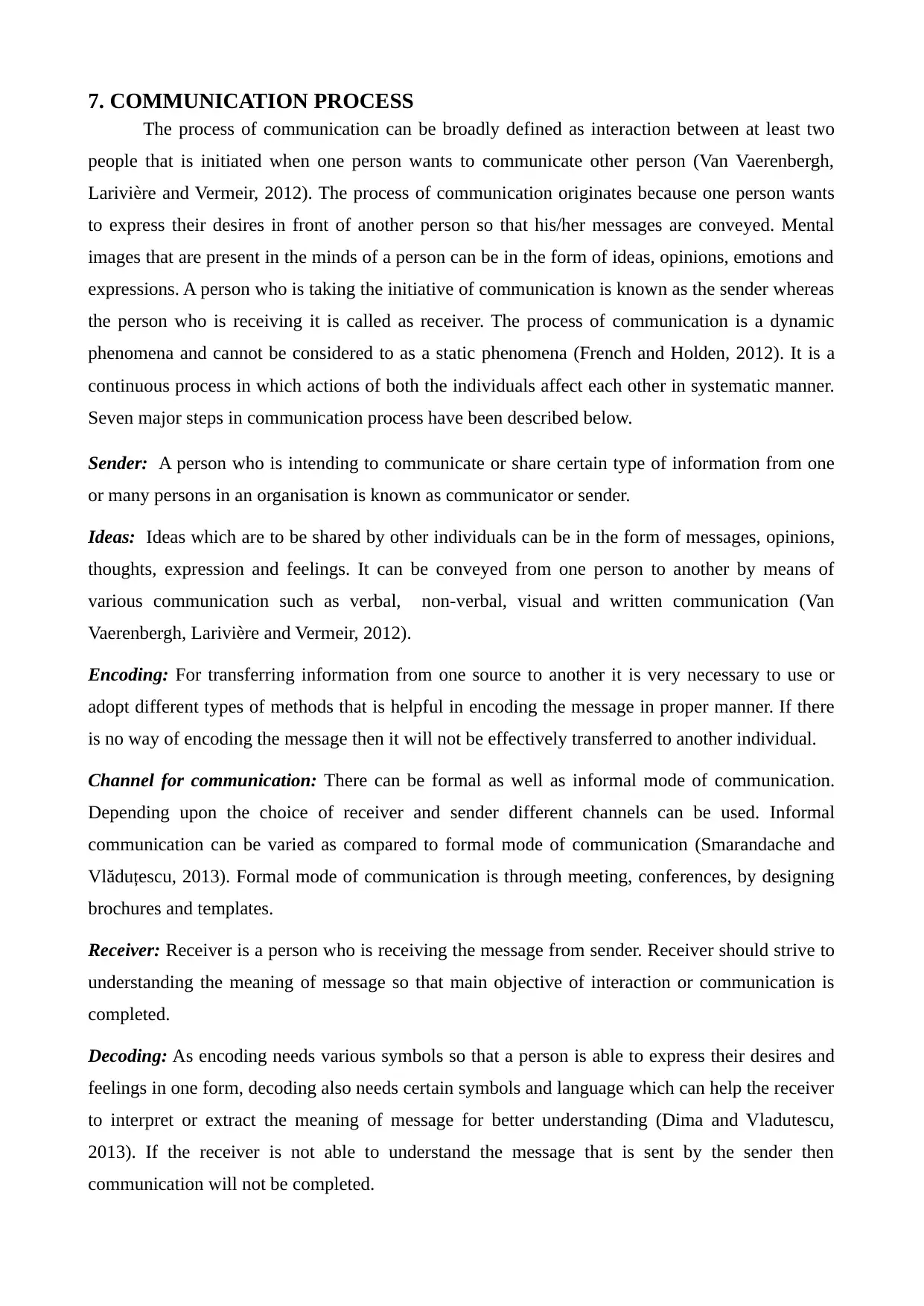
7. COMMUNICATION PROCESS
The process of communication can be broadly defined as interaction between at least two
people that is initiated when one person wants to communicate other person (Van Vaerenbergh,
Larivière and Vermeir, 2012). The process of communication originates because one person wants
to express their desires in front of another person so that his/her messages are conveyed. Mental
images that are present in the minds of a person can be in the form of ideas, opinions, emotions and
expressions. A person who is taking the initiative of communication is known as the sender whereas
the person who is receiving it is called as receiver. The process of communication is a dynamic
phenomena and cannot be considered to as a static phenomena (French and Holden, 2012). It is a
continuous process in which actions of both the individuals affect each other in systematic manner.
Seven major steps in communication process have been described below.
Sender: A person who is intending to communicate or share certain type of information from one
or many persons in an organisation is known as communicator or sender.
Ideas: Ideas which are to be shared by other individuals can be in the form of messages, opinions,
thoughts, expression and feelings. It can be conveyed from one person to another by means of
various communication such as verbal, non-verbal, visual and written communication (Van
Vaerenbergh, Larivière and Vermeir, 2012).
Encoding: For transferring information from one source to another it is very necessary to use or
adopt different types of methods that is helpful in encoding the message in proper manner. If there
is no way of encoding the message then it will not be effectively transferred to another individual.
Channel for communication: There can be formal as well as informal mode of communication.
Depending upon the choice of receiver and sender different channels can be used. Informal
communication can be varied as compared to formal mode of communication (Smarandache and
Vlăduțescu, 2013). Formal mode of communication is through meeting, conferences, by designing
brochures and templates.
Receiver: Receiver is a person who is receiving the message from sender. Receiver should strive to
understanding the meaning of message so that main objective of interaction or communication is
completed.
Decoding: As encoding needs various symbols so that a person is able to express their desires and
feelings in one form, decoding also needs certain symbols and language which can help the receiver
to interpret or extract the meaning of message for better understanding (Dima and Vladutescu,
2013). If the receiver is not able to understand the message that is sent by the sender then
communication will not be completed.
The process of communication can be broadly defined as interaction between at least two
people that is initiated when one person wants to communicate other person (Van Vaerenbergh,
Larivière and Vermeir, 2012). The process of communication originates because one person wants
to express their desires in front of another person so that his/her messages are conveyed. Mental
images that are present in the minds of a person can be in the form of ideas, opinions, emotions and
expressions. A person who is taking the initiative of communication is known as the sender whereas
the person who is receiving it is called as receiver. The process of communication is a dynamic
phenomena and cannot be considered to as a static phenomena (French and Holden, 2012). It is a
continuous process in which actions of both the individuals affect each other in systematic manner.
Seven major steps in communication process have been described below.
Sender: A person who is intending to communicate or share certain type of information from one
or many persons in an organisation is known as communicator or sender.
Ideas: Ideas which are to be shared by other individuals can be in the form of messages, opinions,
thoughts, expression and feelings. It can be conveyed from one person to another by means of
various communication such as verbal, non-verbal, visual and written communication (Van
Vaerenbergh, Larivière and Vermeir, 2012).
Encoding: For transferring information from one source to another it is very necessary to use or
adopt different types of methods that is helpful in encoding the message in proper manner. If there
is no way of encoding the message then it will not be effectively transferred to another individual.
Channel for communication: There can be formal as well as informal mode of communication.
Depending upon the choice of receiver and sender different channels can be used. Informal
communication can be varied as compared to formal mode of communication (Smarandache and
Vlăduțescu, 2013). Formal mode of communication is through meeting, conferences, by designing
brochures and templates.
Receiver: Receiver is a person who is receiving the message from sender. Receiver should strive to
understanding the meaning of message so that main objective of interaction or communication is
completed.
Decoding: As encoding needs various symbols so that a person is able to express their desires and
feelings in one form, decoding also needs certain symbols and language which can help the receiver
to interpret or extract the meaning of message for better understanding (Dima and Vladutescu,
2013). If the receiver is not able to understand the message that is sent by the sender then
communication will not be completed.
⊘ This is a preview!⊘
Do you want full access?
Subscribe today to unlock all pages.

Trusted by 1+ million students worldwide
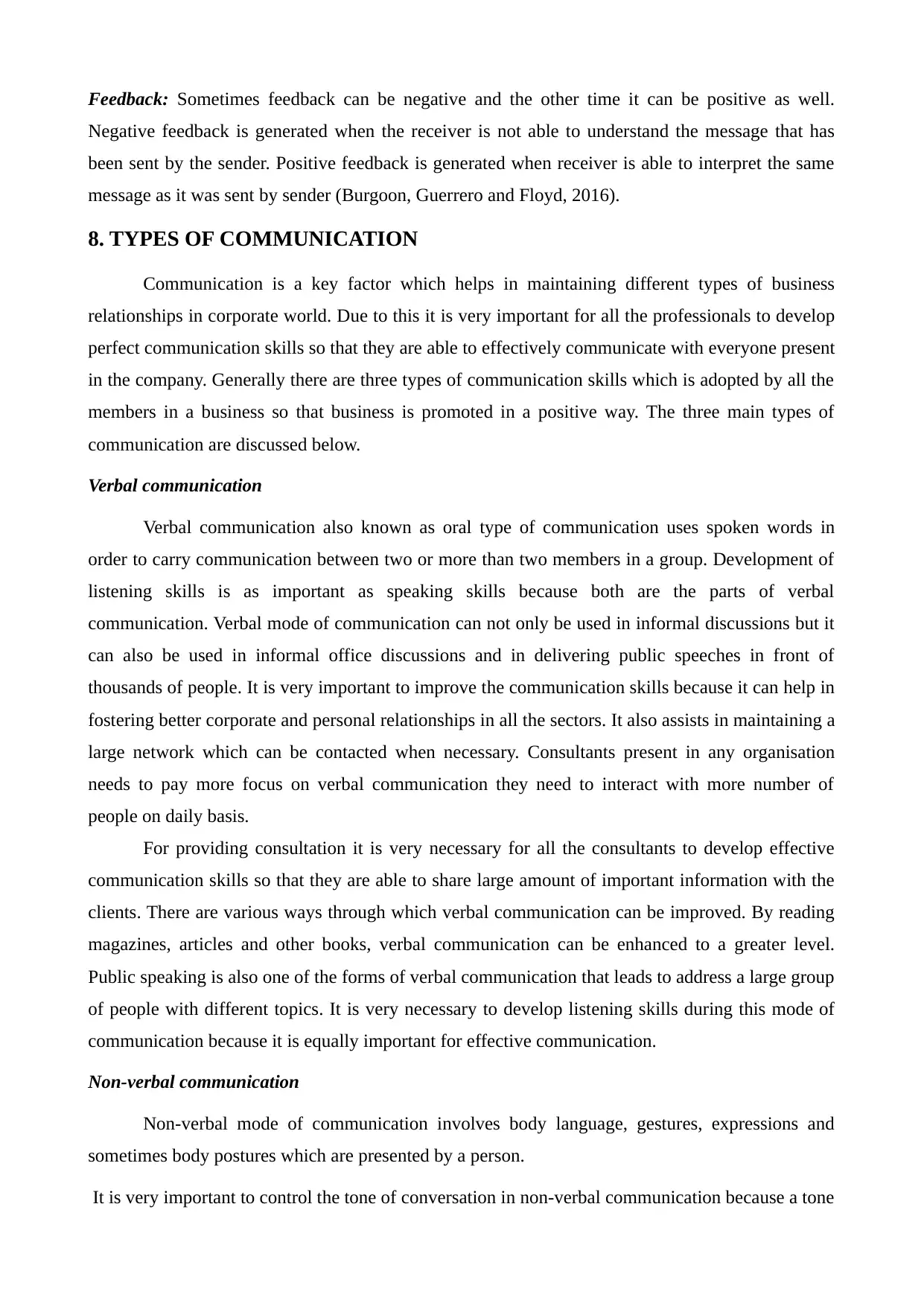
Feedback: Sometimes feedback can be negative and the other time it can be positive as well.
Negative feedback is generated when the receiver is not able to understand the message that has
been sent by the sender. Positive feedback is generated when receiver is able to interpret the same
message as it was sent by sender (Burgoon, Guerrero and Floyd, 2016).
8. TYPES OF COMMUNICATION
Communication is a key factor which helps in maintaining different types of business
relationships in corporate world. Due to this it is very important for all the professionals to develop
perfect communication skills so that they are able to effectively communicate with everyone present
in the company. Generally there are three types of communication skills which is adopted by all the
members in a business so that business is promoted in a positive way. The three main types of
communication are discussed below.
Verbal communication
Verbal communication also known as oral type of communication uses spoken words in
order to carry communication between two or more than two members in a group. Development of
listening skills is as important as speaking skills because both are the parts of verbal
communication. Verbal mode of communication can not only be used in informal discussions but it
can also be used in informal office discussions and in delivering public speeches in front of
thousands of people. It is very important to improve the communication skills because it can help in
fostering better corporate and personal relationships in all the sectors. It also assists in maintaining a
large network which can be contacted when necessary. Consultants present in any organisation
needs to pay more focus on verbal communication they need to interact with more number of
people on daily basis.
For providing consultation it is very necessary for all the consultants to develop effective
communication skills so that they are able to share large amount of important information with the
clients. There are various ways through which verbal communication can be improved. By reading
magazines, articles and other books, verbal communication can be enhanced to a greater level.
Public speaking is also one of the forms of verbal communication that leads to address a large group
of people with different topics. It is very necessary to develop listening skills during this mode of
communication because it is equally important for effective communication.
Non-verbal communication
Non-verbal mode of communication involves body language, gestures, expressions and
sometimes body postures which are presented by a person.
It is very important to control the tone of conversation in non-verbal communication because a tone
Negative feedback is generated when the receiver is not able to understand the message that has
been sent by the sender. Positive feedback is generated when receiver is able to interpret the same
message as it was sent by sender (Burgoon, Guerrero and Floyd, 2016).
8. TYPES OF COMMUNICATION
Communication is a key factor which helps in maintaining different types of business
relationships in corporate world. Due to this it is very important for all the professionals to develop
perfect communication skills so that they are able to effectively communicate with everyone present
in the company. Generally there are three types of communication skills which is adopted by all the
members in a business so that business is promoted in a positive way. The three main types of
communication are discussed below.
Verbal communication
Verbal communication also known as oral type of communication uses spoken words in
order to carry communication between two or more than two members in a group. Development of
listening skills is as important as speaking skills because both are the parts of verbal
communication. Verbal mode of communication can not only be used in informal discussions but it
can also be used in informal office discussions and in delivering public speeches in front of
thousands of people. It is very important to improve the communication skills because it can help in
fostering better corporate and personal relationships in all the sectors. It also assists in maintaining a
large network which can be contacted when necessary. Consultants present in any organisation
needs to pay more focus on verbal communication they need to interact with more number of
people on daily basis.
For providing consultation it is very necessary for all the consultants to develop effective
communication skills so that they are able to share large amount of important information with the
clients. There are various ways through which verbal communication can be improved. By reading
magazines, articles and other books, verbal communication can be enhanced to a greater level.
Public speaking is also one of the forms of verbal communication that leads to address a large group
of people with different topics. It is very necessary to develop listening skills during this mode of
communication because it is equally important for effective communication.
Non-verbal communication
Non-verbal mode of communication involves body language, gestures, expressions and
sometimes body postures which are presented by a person.
It is very important to control the tone of conversation in non-verbal communication because a tone
Paraphrase This Document
Need a fresh take? Get an instant paraphrase of this document with our AI Paraphraser
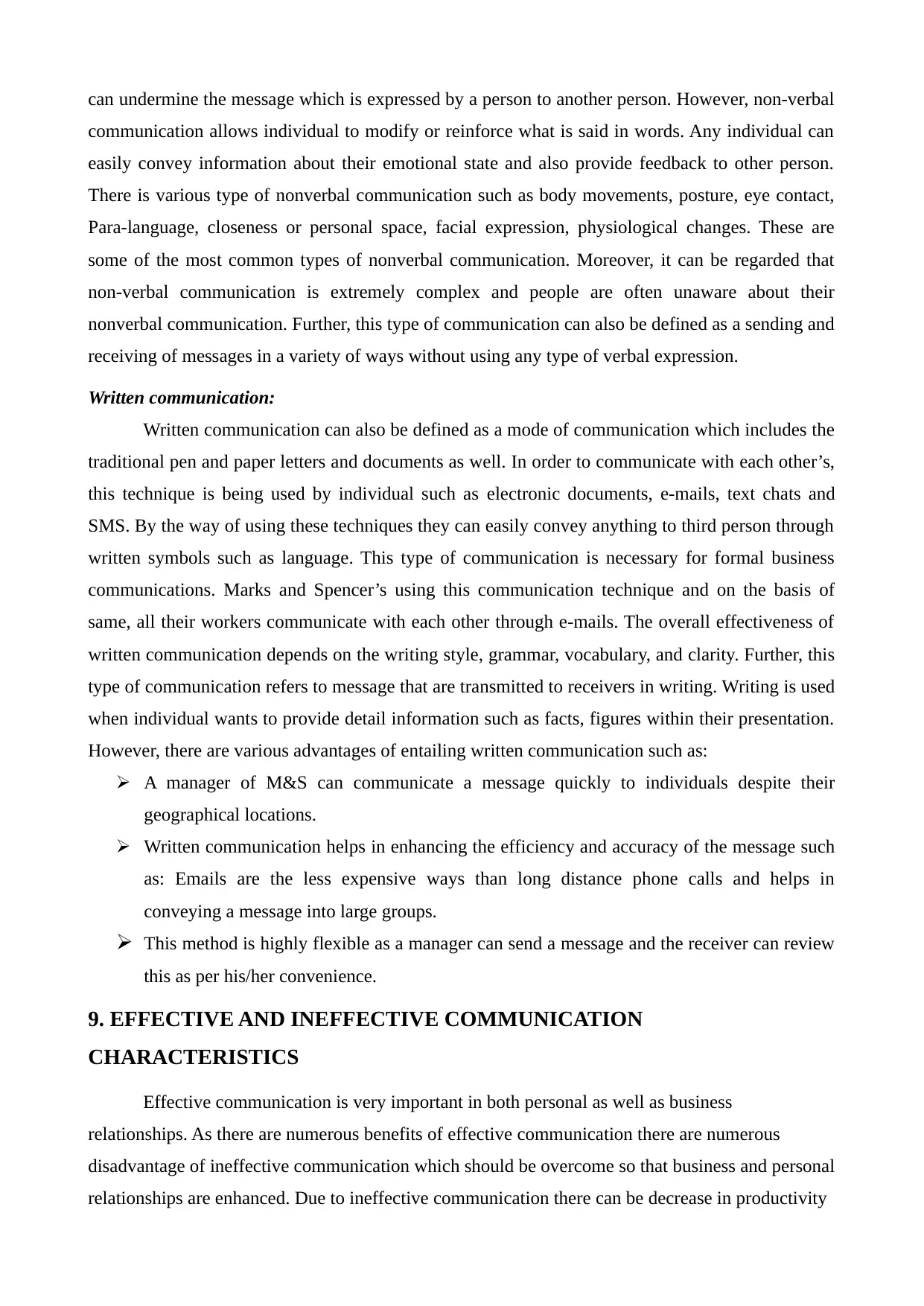
can undermine the message which is expressed by a person to another person. However, non-verbal
communication allows individual to modify or reinforce what is said in words. Any individual can
easily convey information about their emotional state and also provide feedback to other person.
There is various type of nonverbal communication such as body movements, posture, eye contact,
Para-language, closeness or personal space, facial expression, physiological changes. These are
some of the most common types of nonverbal communication. Moreover, it can be regarded that
non-verbal communication is extremely complex and people are often unaware about their
nonverbal communication. Further, this type of communication can also be defined as a sending and
receiving of messages in a variety of ways without using any type of verbal expression.
Written communication:
Written communication can also be defined as a mode of communication which includes the
traditional pen and paper letters and documents as well. In order to communicate with each other’s,
this technique is being used by individual such as electronic documents, e-mails, text chats and
SMS. By the way of using these techniques they can easily convey anything to third person through
written symbols such as language. This type of communication is necessary for formal business
communications. Marks and Spencer’s using this communication technique and on the basis of
same, all their workers communicate with each other through e-mails. The overall effectiveness of
written communication depends on the writing style, grammar, vocabulary, and clarity. Further, this
type of communication refers to message that are transmitted to receivers in writing. Writing is used
when individual wants to provide detail information such as facts, figures within their presentation.
However, there are various advantages of entailing written communication such as:
A manager of M&S can communicate a message quickly to individuals despite their
geographical locations.
Written communication helps in enhancing the efficiency and accuracy of the message such
as: Emails are the less expensive ways than long distance phone calls and helps in
conveying a message into large groups.
This method is highly flexible as a manager can send a message and the receiver can review
this as per his/her convenience.
9. EFFECTIVE AND INEFFECTIVE COMMUNICATION
CHARACTERISTICS
Effective communication is very important in both personal as well as business
relationships. As there are numerous benefits of effective communication there are numerous
disadvantage of ineffective communication which should be overcome so that business and personal
relationships are enhanced. Due to ineffective communication there can be decrease in productivity
communication allows individual to modify or reinforce what is said in words. Any individual can
easily convey information about their emotional state and also provide feedback to other person.
There is various type of nonverbal communication such as body movements, posture, eye contact,
Para-language, closeness or personal space, facial expression, physiological changes. These are
some of the most common types of nonverbal communication. Moreover, it can be regarded that
non-verbal communication is extremely complex and people are often unaware about their
nonverbal communication. Further, this type of communication can also be defined as a sending and
receiving of messages in a variety of ways without using any type of verbal expression.
Written communication:
Written communication can also be defined as a mode of communication which includes the
traditional pen and paper letters and documents as well. In order to communicate with each other’s,
this technique is being used by individual such as electronic documents, e-mails, text chats and
SMS. By the way of using these techniques they can easily convey anything to third person through
written symbols such as language. This type of communication is necessary for formal business
communications. Marks and Spencer’s using this communication technique and on the basis of
same, all their workers communicate with each other through e-mails. The overall effectiveness of
written communication depends on the writing style, grammar, vocabulary, and clarity. Further, this
type of communication refers to message that are transmitted to receivers in writing. Writing is used
when individual wants to provide detail information such as facts, figures within their presentation.
However, there are various advantages of entailing written communication such as:
A manager of M&S can communicate a message quickly to individuals despite their
geographical locations.
Written communication helps in enhancing the efficiency and accuracy of the message such
as: Emails are the less expensive ways than long distance phone calls and helps in
conveying a message into large groups.
This method is highly flexible as a manager can send a message and the receiver can review
this as per his/her convenience.
9. EFFECTIVE AND INEFFECTIVE COMMUNICATION
CHARACTERISTICS
Effective communication is very important in both personal as well as business
relationships. As there are numerous benefits of effective communication there are numerous
disadvantage of ineffective communication which should be overcome so that business and personal
relationships are enhanced. Due to ineffective communication there can be decrease in productivity
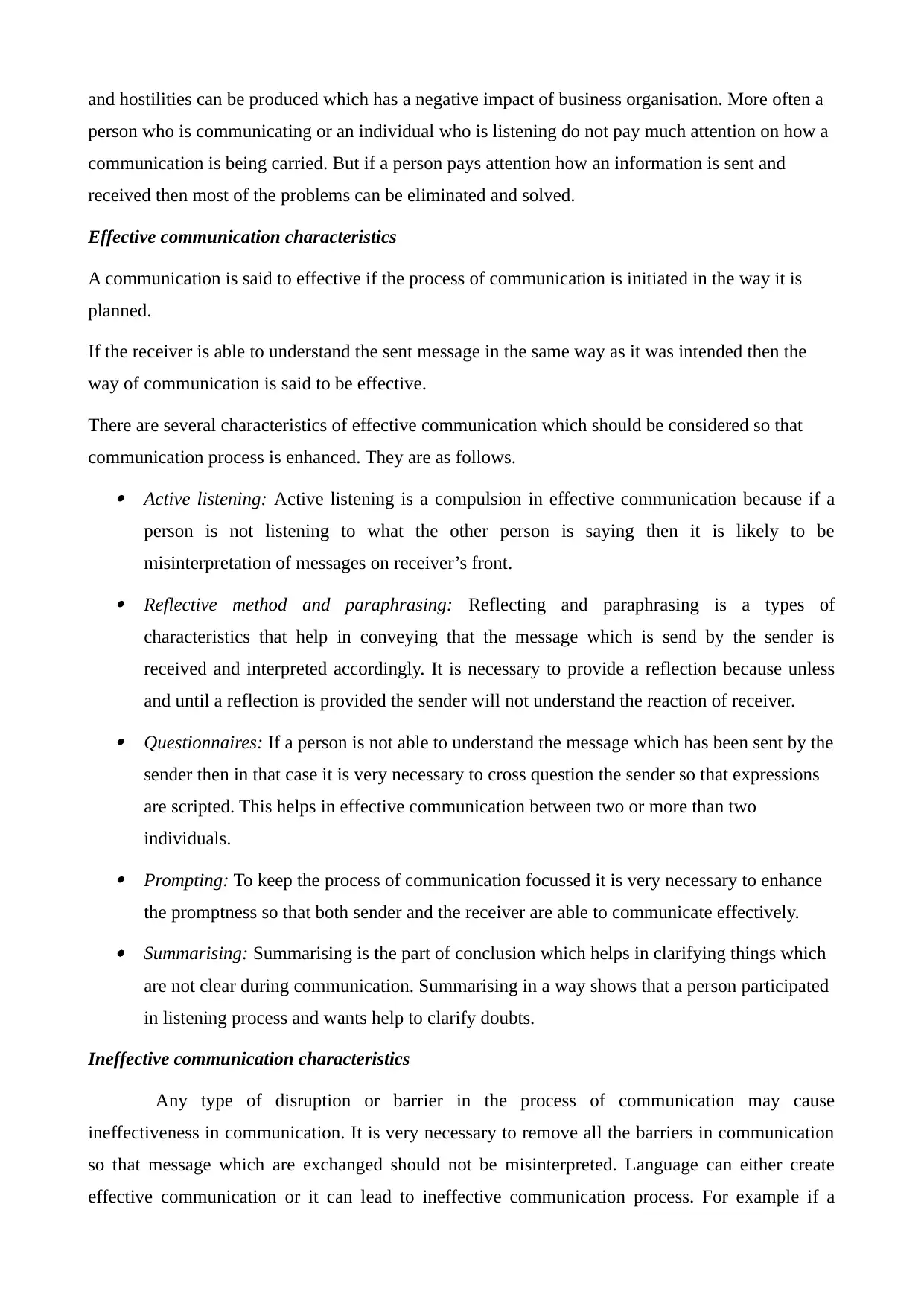
and hostilities can be produced which has a negative impact of business organisation. More often a
person who is communicating or an individual who is listening do not pay much attention on how a
communication is being carried. But if a person pays attention how an information is sent and
received then most of the problems can be eliminated and solved.
Effective communication characteristics
A communication is said to effective if the process of communication is initiated in the way it is
planned.
If the receiver is able to understand the sent message in the same way as it was intended then the
way of communication is said to be effective.
There are several characteristics of effective communication which should be considered so that
communication process is enhanced. They are as follows.
Active listening: Active listening is a compulsion in effective communication because if a
person is not listening to what the other person is saying then it is likely to be
misinterpretation of messages on receiver’s front.
Reflective method and paraphrasing: Reflecting and paraphrasing is a types of
characteristics that help in conveying that the message which is send by the sender is
received and interpreted accordingly. It is necessary to provide a reflection because unless
and until a reflection is provided the sender will not understand the reaction of receiver.
Questionnaires: If a person is not able to understand the message which has been sent by the
sender then in that case it is very necessary to cross question the sender so that expressions
are scripted. This helps in effective communication between two or more than two
individuals.
Prompting: To keep the process of communication focussed it is very necessary to enhance
the promptness so that both sender and the receiver are able to communicate effectively.
Summarising: Summarising is the part of conclusion which helps in clarifying things which
are not clear during communication. Summarising in a way shows that a person participated
in listening process and wants help to clarify doubts.
Ineffective communication characteristics
Any type of disruption or barrier in the process of communication may cause
ineffectiveness in communication. It is very necessary to remove all the barriers in communication
so that message which are exchanged should not be misinterpreted. Language can either create
effective communication or it can lead to ineffective communication process. For example if a
person who is communicating or an individual who is listening do not pay much attention on how a
communication is being carried. But if a person pays attention how an information is sent and
received then most of the problems can be eliminated and solved.
Effective communication characteristics
A communication is said to effective if the process of communication is initiated in the way it is
planned.
If the receiver is able to understand the sent message in the same way as it was intended then the
way of communication is said to be effective.
There are several characteristics of effective communication which should be considered so that
communication process is enhanced. They are as follows.
Active listening: Active listening is a compulsion in effective communication because if a
person is not listening to what the other person is saying then it is likely to be
misinterpretation of messages on receiver’s front.
Reflective method and paraphrasing: Reflecting and paraphrasing is a types of
characteristics that help in conveying that the message which is send by the sender is
received and interpreted accordingly. It is necessary to provide a reflection because unless
and until a reflection is provided the sender will not understand the reaction of receiver.
Questionnaires: If a person is not able to understand the message which has been sent by the
sender then in that case it is very necessary to cross question the sender so that expressions
are scripted. This helps in effective communication between two or more than two
individuals.
Prompting: To keep the process of communication focussed it is very necessary to enhance
the promptness so that both sender and the receiver are able to communicate effectively.
Summarising: Summarising is the part of conclusion which helps in clarifying things which
are not clear during communication. Summarising in a way shows that a person participated
in listening process and wants help to clarify doubts.
Ineffective communication characteristics
Any type of disruption or barrier in the process of communication may cause
ineffectiveness in communication. It is very necessary to remove all the barriers in communication
so that message which are exchanged should not be misinterpreted. Language can either create
effective communication or it can lead to ineffective communication process. For example if a
⊘ This is a preview!⊘
Do you want full access?
Subscribe today to unlock all pages.

Trusted by 1+ million students worldwide

sender is sending an information in a language which is not understood by the receiver then it will
automatically lead to ineffective communication process. There are barriers and certain
characteristics which leads to ineffective communication in personal as well as professional life.
Reading disabilities: if a written message is sent to a person who has difficulty in reading
then this is also one of the barrier that can produce ineffective communication between
sender and the receiver. Hence it is very necessary to adopt right manner of communication
so that a person is able to understand the message correctly.
Lack of confidence: Lack confidence is one of the most common barrier that is noticed in
communication process. For example if a person has idea about certain business plans but
lack the confidence of expressing it then it is also a type of barrier that can lead to
ineffective communication.
Body language: Body language also plays a very important role in enhancing
communication in a correct manner. If body language is not correct then is shows that a
person is bored and not interested in meetings or business related conversations.
Language misunderstanding
10. 7CS OF COMMUNICATION
Completeness: This factor of communication clearly shows that communication must be complete
by the way of conveying all the messages and facts required by the audience. At the time of
conveying any message, the sender must take into consideration the receiver’s mind and maintain
the appropriate communication with the same. In this regards, it can be regarded that it is the most
effective ways on the basis of same, communication can be completely maintained. It develops the
reputation of an organization and easily gives additional information at the time of requirement.
Moreover, it can be set by the way of having complete and clear communication no questions
further develop in mind. It also persuades the audiences and helps in better decision making as well.
This type of communication technique is highly cost saving where no additional cost is incurred in
conveying the extra message.
Conciseness:
It can be define as a necessity for effective communication and it is having several features
such as it is both time and cost saving. Further, this is second element of 7Cs communication and on
the basis of same sender can covey any message in least possible words without forgoing the other
C’s of communication. Under this type of communication, it provides a short and essential message
in limited words to the audience. This type of message should not be very clear and non-repetitive
in nature. All the messages served in this type of communication are maintained in limited words so
automatically lead to ineffective communication process. There are barriers and certain
characteristics which leads to ineffective communication in personal as well as professional life.
Reading disabilities: if a written message is sent to a person who has difficulty in reading
then this is also one of the barrier that can produce ineffective communication between
sender and the receiver. Hence it is very necessary to adopt right manner of communication
so that a person is able to understand the message correctly.
Lack of confidence: Lack confidence is one of the most common barrier that is noticed in
communication process. For example if a person has idea about certain business plans but
lack the confidence of expressing it then it is also a type of barrier that can lead to
ineffective communication.
Body language: Body language also plays a very important role in enhancing
communication in a correct manner. If body language is not correct then is shows that a
person is bored and not interested in meetings or business related conversations.
Language misunderstanding
10. 7CS OF COMMUNICATION
Completeness: This factor of communication clearly shows that communication must be complete
by the way of conveying all the messages and facts required by the audience. At the time of
conveying any message, the sender must take into consideration the receiver’s mind and maintain
the appropriate communication with the same. In this regards, it can be regarded that it is the most
effective ways on the basis of same, communication can be completely maintained. It develops the
reputation of an organization and easily gives additional information at the time of requirement.
Moreover, it can be set by the way of having complete and clear communication no questions
further develop in mind. It also persuades the audiences and helps in better decision making as well.
This type of communication technique is highly cost saving where no additional cost is incurred in
conveying the extra message.
Conciseness:
It can be define as a necessity for effective communication and it is having several features
such as it is both time and cost saving. Further, this is second element of 7Cs communication and on
the basis of same sender can covey any message in least possible words without forgoing the other
C’s of communication. Under this type of communication, it provides a short and essential message
in limited words to the audience. This type of message should not be very clear and non-repetitive
in nature. All the messages served in this type of communication are maintained in limited words so
Paraphrase This Document
Need a fresh take? Get an instant paraphrase of this document with our AI Paraphraser
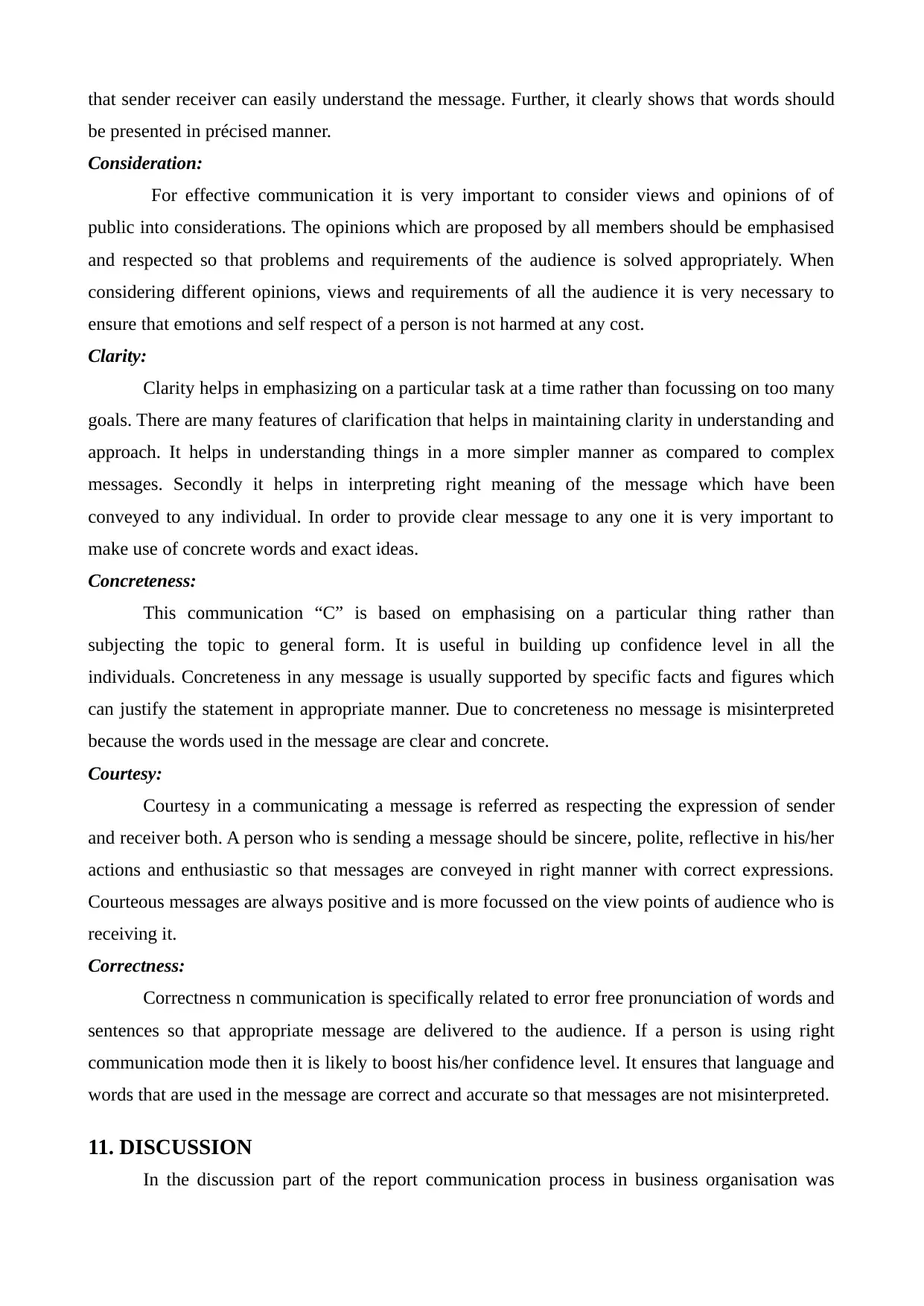
that sender receiver can easily understand the message. Further, it clearly shows that words should
be presented in précised manner.
Consideration:
For effective communication it is very important to consider views and opinions of of
public into considerations. The opinions which are proposed by all members should be emphasised
and respected so that problems and requirements of the audience is solved appropriately. When
considering different opinions, views and requirements of all the audience it is very necessary to
ensure that emotions and self respect of a person is not harmed at any cost.
Clarity:
Clarity helps in emphasizing on a particular task at a time rather than focussing on too many
goals. There are many features of clarification that helps in maintaining clarity in understanding and
approach. It helps in understanding things in a more simpler manner as compared to complex
messages. Secondly it helps in interpreting right meaning of the message which have been
conveyed to any individual. In order to provide clear message to any one it is very important to
make use of concrete words and exact ideas.
Concreteness:
This communication “C” is based on emphasising on a particular thing rather than
subjecting the topic to general form. It is useful in building up confidence level in all the
individuals. Concreteness in any message is usually supported by specific facts and figures which
can justify the statement in appropriate manner. Due to concreteness no message is misinterpreted
because the words used in the message are clear and concrete.
Courtesy:
Courtesy in a communicating a message is referred as respecting the expression of sender
and receiver both. A person who is sending a message should be sincere, polite, reflective in his/her
actions and enthusiastic so that messages are conveyed in right manner with correct expressions.
Courteous messages are always positive and is more focussed on the view points of audience who is
receiving it.
Correctness:
Correctness n communication is specifically related to error free pronunciation of words and
sentences so that appropriate message are delivered to the audience. If a person is using right
communication mode then it is likely to boost his/her confidence level. It ensures that language and
words that are used in the message are correct and accurate so that messages are not misinterpreted.
11. DISCUSSION
In the discussion part of the report communication process in business organisation was
be presented in précised manner.
Consideration:
For effective communication it is very important to consider views and opinions of of
public into considerations. The opinions which are proposed by all members should be emphasised
and respected so that problems and requirements of the audience is solved appropriately. When
considering different opinions, views and requirements of all the audience it is very necessary to
ensure that emotions and self respect of a person is not harmed at any cost.
Clarity:
Clarity helps in emphasizing on a particular task at a time rather than focussing on too many
goals. There are many features of clarification that helps in maintaining clarity in understanding and
approach. It helps in understanding things in a more simpler manner as compared to complex
messages. Secondly it helps in interpreting right meaning of the message which have been
conveyed to any individual. In order to provide clear message to any one it is very important to
make use of concrete words and exact ideas.
Concreteness:
This communication “C” is based on emphasising on a particular thing rather than
subjecting the topic to general form. It is useful in building up confidence level in all the
individuals. Concreteness in any message is usually supported by specific facts and figures which
can justify the statement in appropriate manner. Due to concreteness no message is misinterpreted
because the words used in the message are clear and concrete.
Courtesy:
Courtesy in a communicating a message is referred as respecting the expression of sender
and receiver both. A person who is sending a message should be sincere, polite, reflective in his/her
actions and enthusiastic so that messages are conveyed in right manner with correct expressions.
Courteous messages are always positive and is more focussed on the view points of audience who is
receiving it.
Correctness:
Correctness n communication is specifically related to error free pronunciation of words and
sentences so that appropriate message are delivered to the audience. If a person is using right
communication mode then it is likely to boost his/her confidence level. It ensures that language and
words that are used in the message are correct and accurate so that messages are not misinterpreted.
11. DISCUSSION
In the discussion part of the report communication process in business organisation was
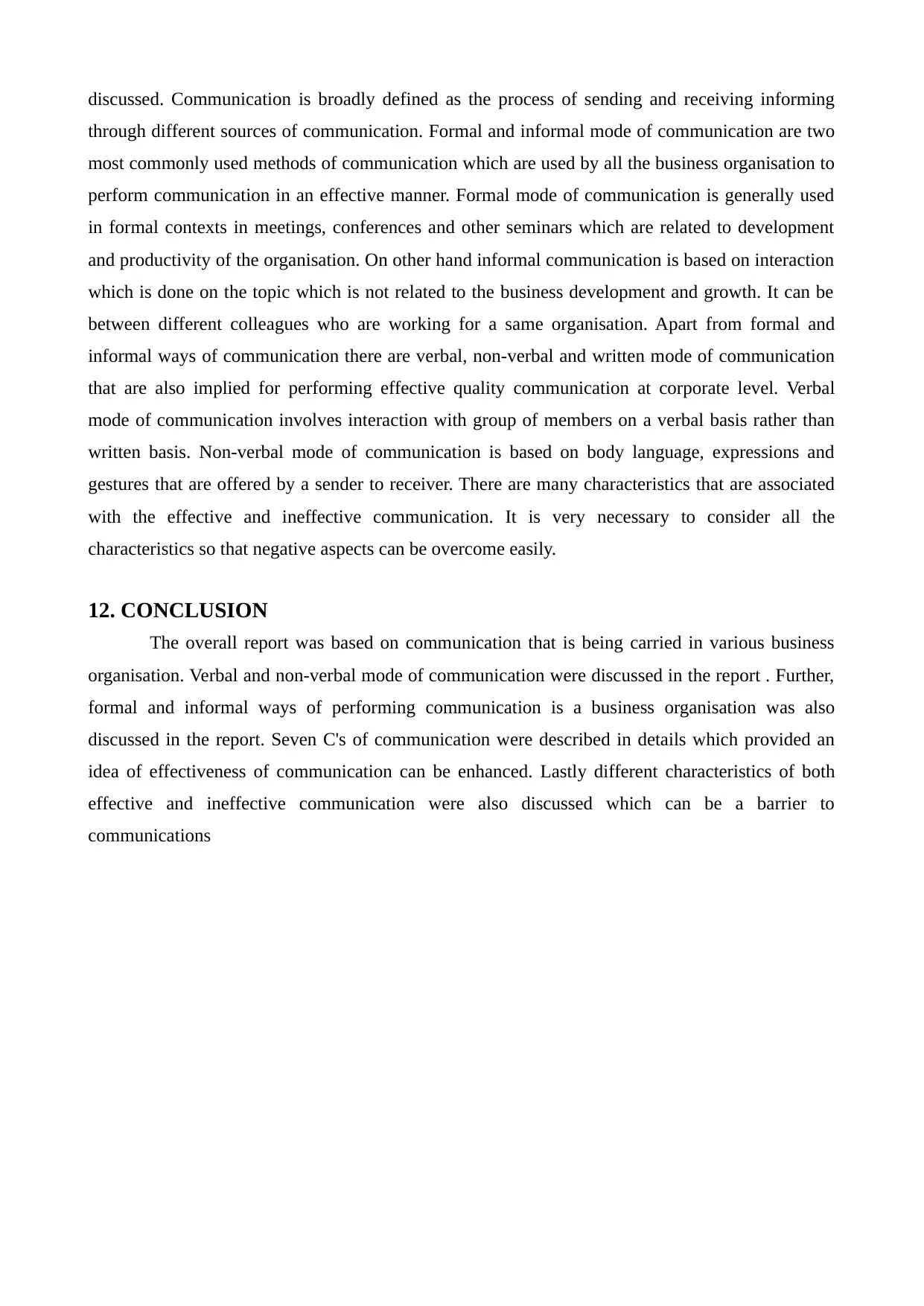
discussed. Communication is broadly defined as the process of sending and receiving informing
through different sources of communication. Formal and informal mode of communication are two
most commonly used methods of communication which are used by all the business organisation to
perform communication in an effective manner. Formal mode of communication is generally used
in formal contexts in meetings, conferences and other seminars which are related to development
and productivity of the organisation. On other hand informal communication is based on interaction
which is done on the topic which is not related to the business development and growth. It can be
between different colleagues who are working for a same organisation. Apart from formal and
informal ways of communication there are verbal, non-verbal and written mode of communication
that are also implied for performing effective quality communication at corporate level. Verbal
mode of communication involves interaction with group of members on a verbal basis rather than
written basis. Non-verbal mode of communication is based on body language, expressions and
gestures that are offered by a sender to receiver. There are many characteristics that are associated
with the effective and ineffective communication. It is very necessary to consider all the
characteristics so that negative aspects can be overcome easily.
12. CONCLUSION
The overall report was based on communication that is being carried in various business
organisation. Verbal and non-verbal mode of communication were discussed in the report . Further,
formal and informal ways of performing communication is a business organisation was also
discussed in the report. Seven C's of communication were described in details which provided an
idea of effectiveness of communication can be enhanced. Lastly different characteristics of both
effective and ineffective communication were also discussed which can be a barrier to
communications
through different sources of communication. Formal and informal mode of communication are two
most commonly used methods of communication which are used by all the business organisation to
perform communication in an effective manner. Formal mode of communication is generally used
in formal contexts in meetings, conferences and other seminars which are related to development
and productivity of the organisation. On other hand informal communication is based on interaction
which is done on the topic which is not related to the business development and growth. It can be
between different colleagues who are working for a same organisation. Apart from formal and
informal ways of communication there are verbal, non-verbal and written mode of communication
that are also implied for performing effective quality communication at corporate level. Verbal
mode of communication involves interaction with group of members on a verbal basis rather than
written basis. Non-verbal mode of communication is based on body language, expressions and
gestures that are offered by a sender to receiver. There are many characteristics that are associated
with the effective and ineffective communication. It is very necessary to consider all the
characteristics so that negative aspects can be overcome easily.
12. CONCLUSION
The overall report was based on communication that is being carried in various business
organisation. Verbal and non-verbal mode of communication were discussed in the report . Further,
formal and informal ways of performing communication is a business organisation was also
discussed in the report. Seven C's of communication were described in details which provided an
idea of effectiveness of communication can be enhanced. Lastly different characteristics of both
effective and ineffective communication were also discussed which can be a barrier to
communications
⊘ This is a preview!⊘
Do you want full access?
Subscribe today to unlock all pages.

Trusted by 1+ million students worldwide
1 out of 14
Related Documents
Your All-in-One AI-Powered Toolkit for Academic Success.
+13062052269
info@desklib.com
Available 24*7 on WhatsApp / Email
![[object Object]](/_next/static/media/star-bottom.7253800d.svg)
Unlock your academic potential
Copyright © 2020–2025 A2Z Services. All Rights Reserved. Developed and managed by ZUCOL.





